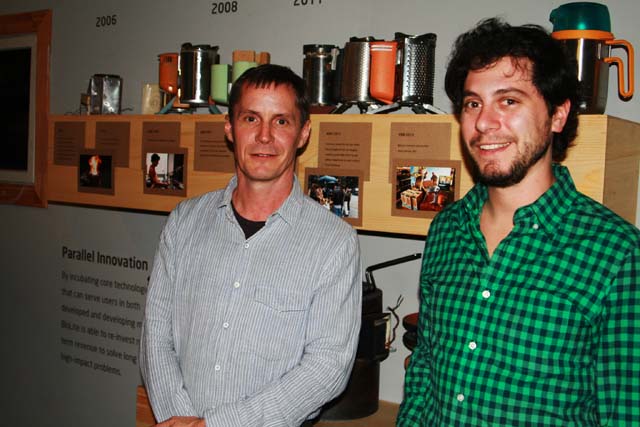Start small, you might find something big.
BioLite started as a better camp stove by some outdoor enthusiasts who wanted to leave a little less of a mark with their weekend excursions, but after a few iterations they realized that their invention also fit into a global mission.
Jonathan Cedar, CEO of BioLite, walked Technically Brooklyn through the evolution of the company’s business vision and its two key products’ iterations, the CampStove and HomeStove, at a Thursday open house held for the BioLite community in their Dumbo offices on Jay Street.
Cedar pointed out some interesting learning moments along the way, both technical and cultural. Plus, we have a better sense of what makes the products work.
Photos below include a collection of the CampStove’s prototypes through to the final market product. You can see about 15 percent of the iterations, Cedar said. It all started, though, after he and his partners had been on camping trip and started to ask, “What if you could burn wood as clean as gas?”
In 2006, they began developing the idea, before wood burning has come back into vogue for its improved efficiency.
Here’s their first prototype, which may look a little clunky, but delivered a powerful, even flame. It was a strong minimum viable product, and they knew they were on to something.

In 2008, they took the CampStove to a conference in Seattle on wood burning stoves. At that point, they were still focused on their camping product, but Cedar told us that everyone there was talking about the need for a better cooking stove for the developing world. They were stunned to hear of the global public health impact of cooking over an open fire.
Like this:

That’s when Cedar and Drummond came to pursue what the company calls “parrallel innovation.” We wrote recently about the company’s work on the ground, today, in Africa and India. As he described it, the parallel innovation model is about incubating a core technology platform in the developed world, in order to pay for the time expense of building a new market in the developing world, for a different application of that core technology.
In other words, the CampStove’s success here helped the HomeStove expand in places where traditional open flame cooking methods are still used.
Here’s the first HomeStove prototype:

Here’s the latest, with real fire in it, at the BioLite HQ.

Here’s a live readout of the pollutants coming off the fire above, inside the lab:

The pollutant levels stayed steady. Too bad they didn’t have a real camp fire to compare it too, but it was an indoor event.
Cedar quit his job in 2009 and went to India to work on a business plan. He spent about 18 months doing that and getting a feel for how people cooked in the developing world. By 2011, they were ready to seek investors with a strong sense for how to move forward.
By the third iteration of the HomeStove, they had the product below. It was compact and worked just as they wanted. It could deliver all the flame needed for cooking with less space.

Here’s what they found: it was seen as too small. BioLite doesn’t just have to overcome engineering challenges, but they also need to overcome the cultural challenges of convincing people to adopt a different approach to cooking than their mothers and grandmothers have used before them.
Cedar told us that as they distributed prototypes in the developing world, many users found this iteration to be “toy like.” It was too small to be taken seriously.
While compact design is a virtue in their CampStove, it proved to be a liability for the HomeStove. So they moved to a fuller design, which arrived at this version of the HomeStove, shown with its own ancestors in the background:

And here’s a cross-section of both the HomeStove and its thermal unit, which also generates electrity for an LED light or charging portable electronic devices:








